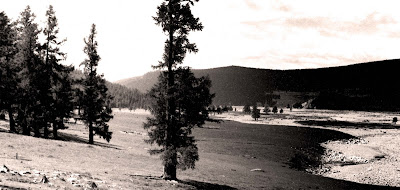 That's what it felt like - to be standing on a landscape, so spellbinding, and yet so alien - that it almost felt unreal to actually be there.
That's what it felt like - to be standing on a landscape, so spellbinding, and yet so alien - that it almost felt unreal to actually be there.The steppes of Mongolia spread out like some vast cloak of grey and green over a gently undulating terrain. It seems almost too tidy, too well planned out - compact stands of pine trees cresting every mountain-top. Boulder-strewn riverbeds twist, serpentine, across the valley floors. Closely cropped pastures of grass cling to the ground - everything is in its right place, even the wildflowers grow in a pleasing kaleidoscope of colours.
Its the vastness of the place that gets to you though - you feel insignificant in the scheme of things, as your jeep struggles along a dirt track riddled with potholes. The sheer scarcity of people hits home, as you survey the horizon, and over a distance of say, twenty kilometres or so, only two or three homesteads lie huddled together, with a small herd of livestock scattered nearby. The characteristic yak-skin tents known as Gers are all that these people of the plains have to protect themselves from the elements. We are here during summer and there's already a chill in the air. But when winter hits, it does so with a vengeance - as temperatures fall below zero and the entire country becomes frozen beneath snow and ice.
Yes it is beautiful, but it is a lonely kind of beauty. Even for someone like me who is happy to escape from the boundaries of human society from time to time - this vastness could well become overbearing after a while. Its no wonder the Mongol people seek out each others' company in annual festivals and fairs. A sense of Community is a survival strategy in a place like this, where you could easily lose yourself in a constant landscape that stretches further than the eye can see and the mind can comprehend...
They are tough, these people - sturdy, enduring and tireless in the undertaking of their daily chores. As most of them are herders, horses take centre-stage in their lives. These wiry steeds are almost like living extensions of their riders. They move imperceptibly together across the plains in an ageless scene that could be centuries old. The Horse and the Rider - defining symbols of Mongolia.

We spent a precious few days in their company, and it wasn't long before all my sense of bravado about being able to live this kind of life, flew out of the window. They live right off the land, quite literally. And despite best-laid plans, every day is determined by the elements themselves. Only forward-planning gives these people a fighting chance, plus the ability to react fast to any given situation, be it positive or negative.
"Expect the unexpected" is an unspoken mantra, and the Mongolians' approach to life is to grab it by the throat and hold on for the ride. Yes it is a beautiful life. But a life that they have to work hard for. The blood of the Khans certainly endures out here, in the vast empty plains...




No comments:
Post a Comment